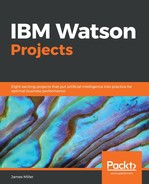In Chapter 3, our use case project focused on analyzing how effective a supply chain is for a retail department store scenario. The automated supply chain scenario looked to provide insights to an organization's supply chain data and processes, in an attempt to find delivery performance problems.
Key takeaways:
- Although supply chain management has multiple objectives, one of the most fundamental is achieving efficient fulfillment. Efficient fulfillment is the process of making inventory readily available to the customer to fulfill demand.
- Readily Available must also be accompanied by the most efficient use of cross-chain resources, maintaining minimal inventory levels, incurring little or no waste and permitting the lowest costs overall.
- Supply chain data is not singular in source, in that it is comprised of a variety of informational data points and collections such as accounts payable, accounts receivable, manufacturing data, cost of goods sold, various vendor records, and so on.
- Rather than obtaining a field-by-field description of the data, you can use the Watson Analytics Exploration feature to get to know data.
- Based upon your Watson Analytics subscription level, there are specific limitations to the data and format that can be loaded.
- To initiate an Explore, you click on the Explore image in the upper left of the Welcome page. Watson Analytics automatically explores your data and presents its findings as a page of entry points or prompts.
- To see the answer to a prompt or question, you click on the question and Watson Analytics runs a query and presents the results in an visualization.
- Watson automates the process of having to: think of a question (query), formulate a query based upon the question, execute the query, review resultant data, think of an appropriate visualization type, create the visualization using the query's result, and draw a conclusion.
- As you type, Watson Analytics autofills column names from the data and quickly generates a list of exploration prompts related to the question.
- You can drill into a prompt and IBM Watson Analytics will provide a relevant visualization.
- Obtaining insights from data with Watson Analytics is accomplished with the Predict feature. The steps for creating a prediction are simple. These steps are referred to as a Prediction Workflow.
- A predictor variable is a variable that can be used to predict the value of another variable.
- When you open a Watson Analytics prediction, the Top Predictors page appears. The spiral visualization you see shows you the top key drivers, or predictors (in color with other predictors in gray). The closer the predictor is to the center of the spiral, the stronger that predictor is.
- The results of predictions in IBM Watson Analytics are presented as a combination of both visual and text insights.
- You use the Assemble capability in Watson Analytics to convey analysis and insights. You can use Assemble to assemble Watson assets as well as external files (such as images) into Watson interactive views. Views can be either dashboards or stories and can be easily shared with others.
- A Watson Analytics dashboard is a kind of view that helps you to monitor events or activities at a glance by providing key insights and analysis about data on one or more pages or screens. Types of dashboard include single-page, tabbed, and infographic.
